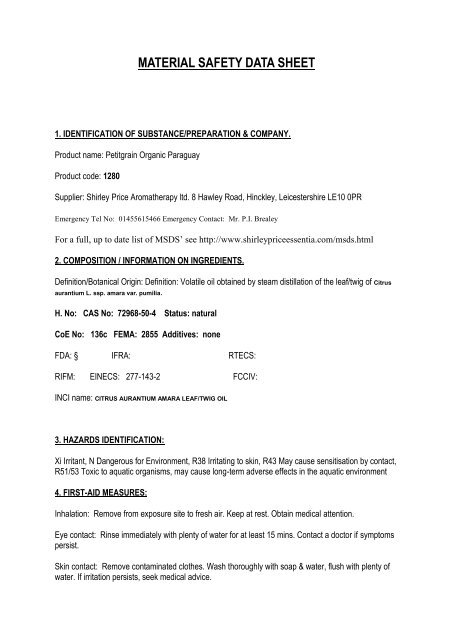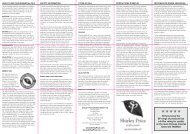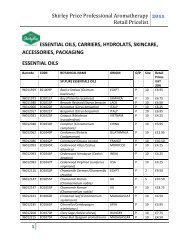MATERIAL SAFETY DATA SHEET - Shirley Price
MATERIAL SAFETY DATA SHEET - Shirley Price
MATERIAL SAFETY DATA SHEET - Shirley Price
You also want an ePaper? Increase the reach of your titles
YUMPU automatically turns print PDFs into web optimized ePapers that Google loves.
<strong>MATERIAL</strong> <strong>SAFETY</strong> <strong>DATA</strong> <strong>SHEET</strong><br />
1. IDENTIFICATION OF SUBSTANCE/PREPARATION & COMPANY.<br />
Product name: Petitgrain Organic Paraguay<br />
Product code: 1280<br />
Supplier: <strong>Shirley</strong> <strong>Price</strong> Aromatherapy ltd. 8 Hawley Road, Hinckley, Leicestershire LE10 0PR<br />
Emergency Tel No: 01455615466 Emergency Contact: Mr. P.I. Brealey<br />
For a full, up to date list of MSDS’ see http://www.shirleypriceessentia.com/msds.html<br />
2. COMPOSITION / INFORMATION ON INGREDIENTS.<br />
Definition/Botanical Origin: Definition: Volatile oil obtained by steam distillation of the leaf/twig of Citrus<br />
aurantium L. ssp. amara var. pumilia.<br />
H. No: CAS No: 72968-50-4 Status: natural<br />
CoE No: 136c FEMA: 2855 Additives: none<br />
FDA: § IFRA: RTECS:<br />
RIFM: EINECS: 277-143-2 FCCIV:<br />
INCI name: CITRUS AURANTIUM AMARA LEAF/TWIG OIL<br />
3. HAZARDS IDENTIFICATION:<br />
Xi Irritant, N Dangerous for Environment, R38 Irritating to skin, R43 May cause sensitisation by contact,<br />
R51/53 Toxic to aquatic organisms, may cause long-term adverse effects in the aquatic environment<br />
4. FIRST-AID MEASURES:<br />
Inhalation: Remove from exposure site to fresh air. Keep at rest. Obtain medical attention.<br />
Eye contact: Rinse immediately with plenty of water for at least 15 mins. Contact a doctor if symptoms<br />
persist.<br />
Skin contact: Remove contaminated clothes. Wash thoroughly with soap & water, flush with plenty of<br />
water. If irritation persists, seek medical advice.
Ingestion: Rinse mouth out with water. Seek medical advice immediately.<br />
Other: When assessing action take Risk & Safety Phrases into account (Section 15)<br />
5. FIRE FIGHTING MEASURES.<br />
Extinguishing media Use CO2, Dry Powder or Foam type Extinguishers, spraying extinguishing media<br />
to base of flames. Do not use direct water jet on burning material.<br />
Special measures: Avoid vapour inhalation. Keep away from sources of ignition. Do not smoke. Wear<br />
positive pressure self-contained breathing apparatus & protective clothing.<br />
Extinguishing procedures: Closed containers may build up pressure when exposed to heat and should<br />
be cooled with water spray.<br />
6. ACCIDENTAL RELEASE MEASURES.<br />
Personal precautions: Avoid inhalation & direct contact with skin & eyes. Use individual protective<br />
equipment (safety glasses, waterproof-boots, suitable protective clothing) in case of major spillages.<br />
Environment precautions: Keep away from drains, soils, surface & groundwaters.<br />
Cleaning up methods Remove all potential ignition sources. Contain spilled material. Cover for<br />
spillages: with an inert or non-combustible inorganic absorbent material, sweep up and remove to an<br />
approved disposal container. Observe state, federal & local disposal regulations.<br />
7. HANDLING & STORAGE.<br />
Precautions in handling: Apply good manufacturing practice & industrial hygiene practices, ensuring<br />
proper ventilation. Observe good personal hygiene, and do not eat, drink or smoke whilst handling.<br />
Storage conditions: Store in tightly closed original container, in a cool, dry & ventilated area away from<br />
heat sources & protected from light. Keep air contact to a minimum.<br />
Fire protection: Keep away from ignition sources & naked flames. Take precautions to avoid static<br />
discharges in working area.<br />
8. EXPOSURE CONTROLS/PERSONAL PROTECTION.<br />
Respiratory protection: Avoid breathing product vapour. Apply local ventilation where possible.<br />
Ventilation: Ensure good ventilation of working area.<br />
Hand protection: Avoid all skin contact. Use chemically resistant gloves if required.<br />
Eye protection: Use safety glasses.<br />
Work/Hygiene practices: Wash hands with soap & water after handling.
9. PHYSICAL & CHEMICAL PROPERTIES.<br />
Colour: Pale yellow to brown yellow<br />
Appearance: Liquid<br />
Odour: Fresh, floral & green<br />
Flash point °C: 75<br />
Specific gravity at 20 0 C: 0.882-0.894<br />
Refractive index @ 20�C: 1.457-1.467<br />
Solubility in vegetable oils: Soluble<br />
Solubility in water: Insoluble<br />
10. STABILITY & REACTIVITY.<br />
Reactivity: It presents no significant reactivity hazards, by itself or in contact with water. Avoid contact<br />
with strong acids, alkali or oxidising agents.<br />
Decomposition: Liable to cause smoke & acrid fumes during combustion: carbon monoxide, carbon<br />
dioxide & other non-identified organic compounds may be formed.<br />
11. TOXICOLOGICAL INFORMATION.<br />
Oral Ingestion LD50 org. >=5g/kg, Dermal Absorption LD50 derm. >=5g/kg. Causes skin irritation &<br />
serious eye damage. Man cause an allergic skin reaction.<br />
12. ECOLOGICAL INFORMATION.<br />
Biodegradability: Data not available<br />
Precautions: Prevent surface contamination of soil, ground & surface water.<br />
13. DISPOSAL CONSIDERATIONS.<br />
Avoid disposing to drainage systems and into the environment. Seek expert advice.<br />
14. TRANSPORT REGULATIONS.<br />
Road (ADR/RID): Class 9 Group III UN: 3082<br />
Air (IATA) : Class 9 Group III UN: 3082<br />
Sea (IMDG): Class 9 Group III UN: 3082 Marine Pollutant<br />
CHIP: See section 15
15. REGULATORY INFORMATION. According to Directive 88/379/EEC<br />
Hazards: Irritant, Dangerous for Environment<br />
Symbols: Xi, N<br />
Risk Phrases:<br />
R10 : Flammable<br />
R38 : Irritating to skin<br />
R41 : Risk of serious damage to eyes<br />
R43 : May cause sensitisation by skin contact<br />
R50/53 : Very toxic to aquatic organisms, may cause long-term adverse effects in the aquatic environment<br />
R51/53 : Toxic to aquatic organisms, may cause long-term adverse effects in the aquatic environment<br />
R52/53 : Harmful to aquatic organisms, may cause long-term adverse effects in the aquatic environment<br />
R65 : Harmful: may cause lung damage if swallowed<br />
Safety Phrases: S24 : Avoid contact with skin<br />
S37 : Wear suitable gloves<br />
S61 : Avoid release to the environment. Refer to special instructions/safety data sheet<br />
Full list of Hazards, symbols & phrases available at http://www.hse.gov.uk/chip/phrases.htm<br />
16. OTHER INFORMATION.<br />
Cosmetics Directive 7 th Amendment: Restrictions may apply. A source of Linalool (18,00 to 32,00%),<br />
Geraniol (
In-line with general product specification. Always satisfy suitability for specific application.<br />
The data provided in this material safety data sheet is meant to represent typical data/analysis for this<br />
product and is correct to the best of our knowledge. The data was obtained from current and reliable<br />
sources, but is supplied without warranty, expressed or implied, regarding its’ correctness or accuracy.<br />
It is the user's responsibility to determine safe conditions for the use of this product, and to assume<br />
liability for loss, injury, damage or expense arising from improper use of this product. The information<br />
provided does not constitute a contract to supply to any specification, or for any given application, and<br />
buyers should seek to verify their requirements and product use.<br />
……………………<br />
Mr G.P. Brealey<br />
Technical Manager<br />
11/11




